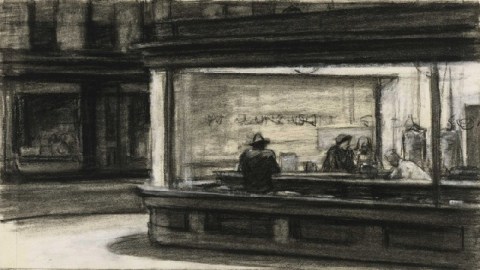Edward Hopper’s Noir Drawings

Despite knowing the full-colored truth, I’ve always pictured the 1930s and 1940s in black and white. Laura,The Big Sleep, The Killers, Shadow of a Doubt, and countless other examples of classic American film noir define that era visually for me with their stark contrasts of dark and light paralleling the paradoxes of American society of itself. The starkly titled exhibition Hopper Drawing, which runs at the Whitney Museum of American Art in New York City through October 6th, examines how Edward Hopper, the preeminent painter of that era, used drawing to develop iconic works such as Nighthawks and New York Movie. As familiar as Hopper’s signature works are, seeing them in black and white through Hopper’s undervalued draftsmanship is seeing them anew.
It’s an understandable misnomer that Hopper’s a poor draftsman. If you look at his finished paintings, the mood and contrasts of light and dark take priority over precision. Attitude wins over exactitude. But Hopper learned his craft beginning with old school old world training in France. Longing to be the quintessentially American painter in later years, Hopper downplayed and nearly denied the Frenchness of his beginnings and his Francophile love of French poetry and painting. An academic charcoal nude titled Female Nude on Model’s Platform blows Hopper’s cover and reminds us that spent his final school years learning drawing in a French atelier. Seeing a Self-Portrait and Hand Studies from 1900, you recognize the 18 year old Hopper paying his dues and looking in the mirror in hopes of finding the artist he would become. A taut, precise Self-Portrait from 1945 in chalk and charcoal on paper by the 63-year-old Hopper answers any doubts of his younger self.
Hopper became Hopper when he found his home in the interplay of light and shadow—noir itself. Standing Female Nude by Window (Sketch for Etching) embodies the new Hopper of the Great War period, as the academic approach meets German Expressionism and arrives at a prototype of noir. Who is she? Where is she? What is she looking at, or for? The directness of the nude woman on the model’s platform is gone. Another mystery woman emerges in 1939’s New York Movie. A series of studies for New York Movie in Hopper Drawing show Hopper’s thought process from rough idea to final painting.
As curator Carter Foster explains in the audio guide, “What’s different [in the earliest drawings for New York Movie] is the spatial compression, the side aisle becomes smaller. The staircase becomes collapsed into an arched opening with a heavy curtain in front of it, as opposed to being much more open in the drawing.” But all of that is just the setting for the usherette slumped against a wall. “It’s not that she’s trapped, but she’s wearing this uniform that’s sort of militaristic and she’s got a specific role she’s playing within this ornate palace of escapism. That compression of space is something that is an important part of the painting’s overall effect.” The drawings provide the pieces that Hopper crushes together in the end to create the claustrophobic feeling of a crowded movie theater, even for a solitary usherette on the margins. One of the studies even provides a close up of the usherette, as if Hopper the director were exploring all possible angles before selecting the perfect shot.
But the centerpiece of Hopper Drawing is Nighthawks, of course. The painting stands at the end of a pathway of studies ranging from a bare outline of the contours of the coffee shop window to a fully realized drawing (shown above) that may actually have been drawn after Hopper began working on the painting. “We can also see how [Hopper] was working out the qualities of light that interested him by putting white chalk on the sheet to indicate sort of this harsh fluorescent light that was coming out of the diner and contrasting that to the space of the street with the rich darkness of the chalk, and getting all these subtle modulations in this particular sheet,” Foster points out. In the midst of all charcoal worked darkly into the scene, Hopper forces white chalk to mimic the burning, yet lifeless light of the coffee shop reflected on the faces of the customers. As familiar, actually overfamiliar as Nighthawks is, seeing how Hopper struggled to work out the effect of light in that heart of darkness makes the painting fresh and startling new.
Hopper Drawing ends with Sun in an Empty Room, a late Hopper noir perpetrated in broad daylight. Hopper famously claimed that all he wanted to paint was the play of sunlight on a wall. But with sunlight comes shadow. Hopper, like all the great noir minds (including Alfred Hitchcock, an admirer of Hopper’s work), knew that the scariest shadows were the emptiest, full only of our imagination. In his drawings, Hopper drew on his own imagination to empty out the nonessentials of his academic training while keeping the bare bones standing—contrast, depth, design. Hopper Drawing is like watching a fine film noir full of tension, suspense, and anticipation. There’s not even the shadow of a doubt that Hopper’s drawings help explain not just his paintings, but also the man.
[Image:Edward Hopper (1882–1967). Study for Nighthawks, 1941 or 1942. Fabricated chalk and charcoal on paper; 11 1/8 x 15 in. (28.3 x 38.1 cm). Whitney Museum of American Art, New York; purchase and gift of Josephine N. Hopper by exchange 2011.65.]
[Many thanks to the Whitney Museum of American Art, New York, for providing me with the image above and other press materials related to Hopper Drawing, which runs through October 6, 2013.]





